
From Aspirations to Action: UN at 70
In commemoration of the 70th Anniversary of the United Nations, the Archives and Records Management Section (ARMS) presents key documents, photos and artefacts from the early years of the Organization, spanning from 1945 to 1951.
This virtual exhibition showcases material from seventy years of United Nations archives which are housed at the Organization's Headquarters in New York City. It is structured around four major themes: the foundation of the UN at the San Francisco Conference of 1945, the beginnings of the Organization at the temporary Lake Success Headquarters and the first challenges faced by the Organization in the implementation of humanitarian and disarmament programmes.
“We seek peace—enduring peace. More than an end to war, we want an end to the beginnings of all wars—yes, an end to this brutal, inhumane, and thoroughly impractical method of settling the differences between governments.” “Today we are faced with the preeminent fact that, if civilisation is to survive, we must cultivate the science of human relationships—the ability of all peoples, of all kinds, to live together and work together, in the same world, at peace.”
- American President, Franklin D. Roosevelt, Undelivered Address 13 April 1945
In response to the geopolitical situation in Europe in 1941, American president Franklin D. Roosevelt and British Prime Minister Winston Churchill met in August in Newfoundland (now part of Canada), and in drafting the Atlantic Charter, they set out a vision for a post WWII world, even though the United States had not entered the war at the time. Roosevelt truly believed in the possibility of a world governed by democratic processes, with an international organization serving as an arbiter of disputes and protector of the peace. The Atlantic Charter was the second attempt by the Allied Nations to draft an agreement to promote international cooperation for peace and security, after the Inter-Allied Declaration of June 1941.
Between 1941 and 1945, at a series of international meetings attended by a growing number of Allied Nations—in Teheran, Moscow, Bretton Woods, Dumbarton Oaks and Yalta, the principles of peace, security, international justice, self-determination and human rights were discussed, refined and developed; hereby laying the ground for – as the Atlantic Charter puts it, “the establishment of a wider and permanent system of general security”: the United Nations.
San Francisco Conference of 1945 (UNCIO)
“It is not the purpose of this Conference to draft a treaty of peace in the old sense of that term. It is not our assignment to settle specific questions of territories, boundaries, citizenship and reparations. This Conference will devote its energies and its labours exclusively to the single problem of setting up the essential organisation to keep the peace. You are to write the fundamental charter.”
Address by American President, Harry S. Truman, Conference in San Francisco, 25 April 1945.
As WWII came to a close in the spring of 1945, the representatives of 50 nations came together in San Francisco to review and rewrite the Dumbarton Oaks agreements of 1944. The conference led to the drafting of the United Nations Charter.
The documents and photographs displayed in this section are a small sample of the 3,500 cubic feet of records created at the San Francisco Conference. The documents were subsequently shipped to London to be used by the Preparatory Commission of the United Nations, which met between August and November 1945. The Preparatory Commission was the final milestone in the establishment of the United Nations.
|
Public Support for the San Francisco Conference
|
One of UNCIO's committee meetings, April 1945
|
|
|---|---|---|
 |
 |
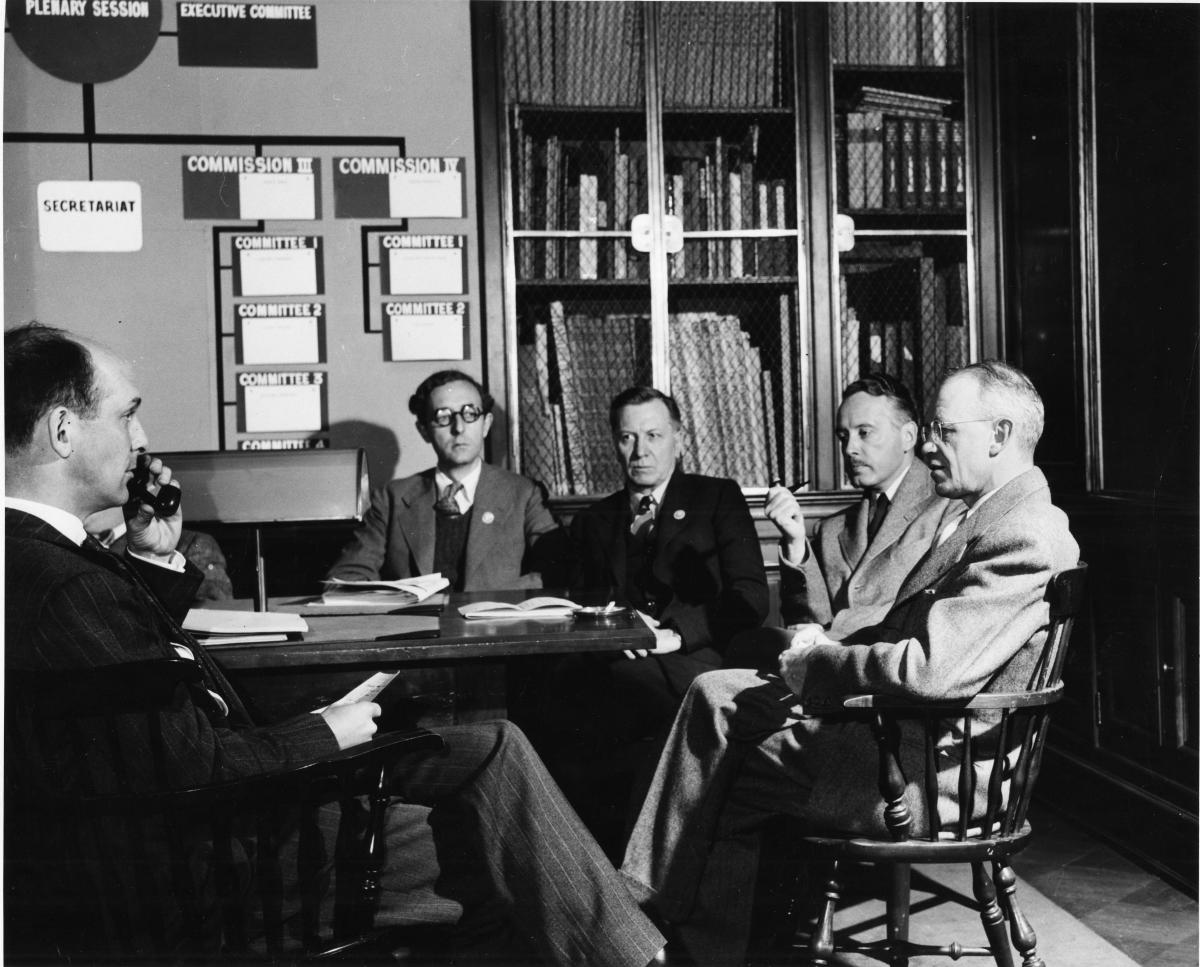 |
|
Members of the public were encouraged to communicate their ideas and thoughts about the San Francisco Conference, and many submitted plans, proposals for songs and flags, as well as expressions of encouragement, like this one from the Sweethearts of Servicemen, Kings County Chapter, Brooklyn, New York, United States. April 1945. |
Public interest in the San Francisco Conference was intense, as demonstrated by the address on this letter mailed from a remote region of France (Puy de Dôme). April 1945. |
UNCIO was the scene of heated debates between the delegations, particularly regarding of the veto powers of the "Big Five" (China, France, the Soviet Union, the United Kingdom and the United States). |
|
Delegates vote during UNCIO |
Delegates read about the end of WWII in May 1945 |
Delegation to UNCIO from Liberia |
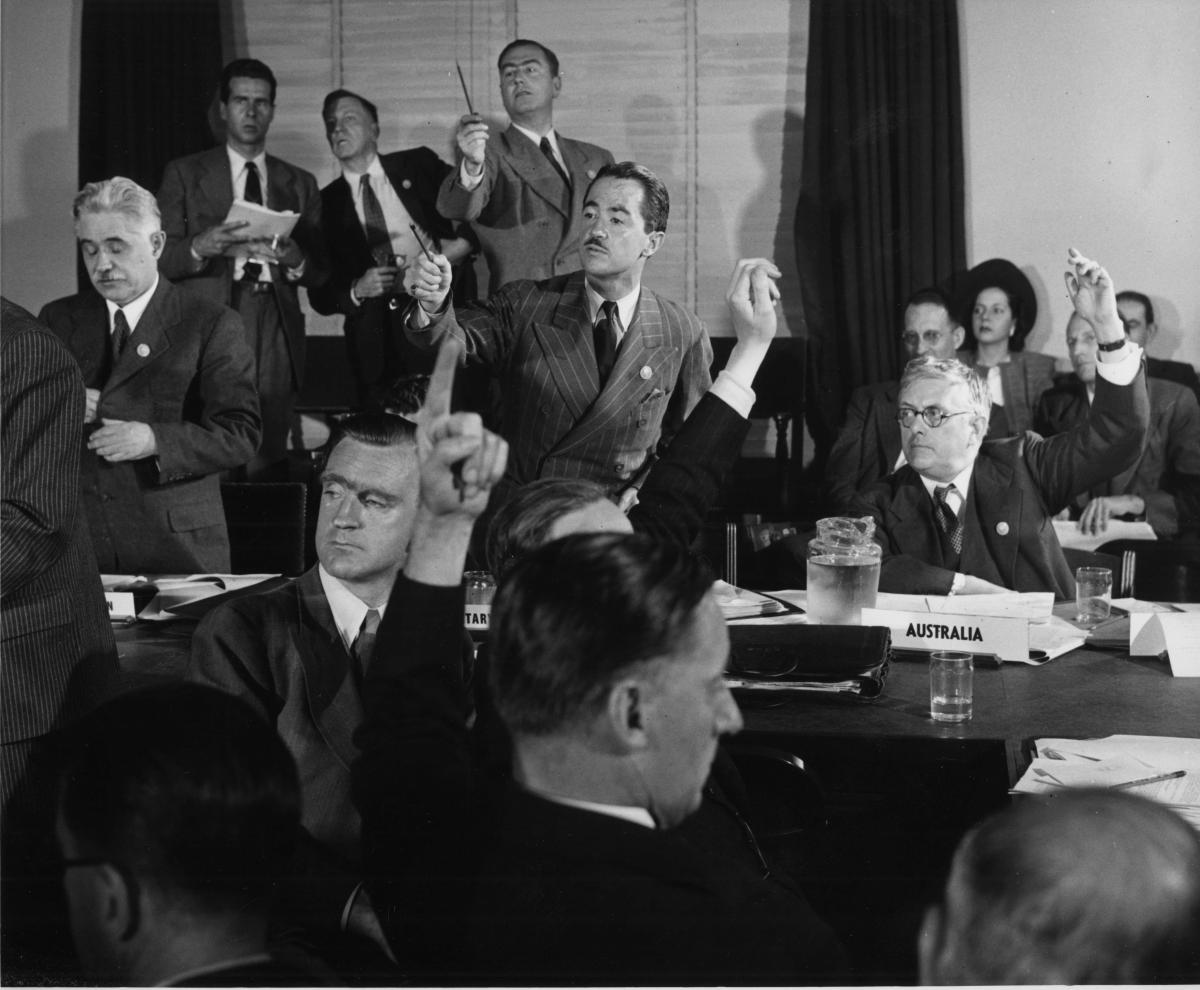 |
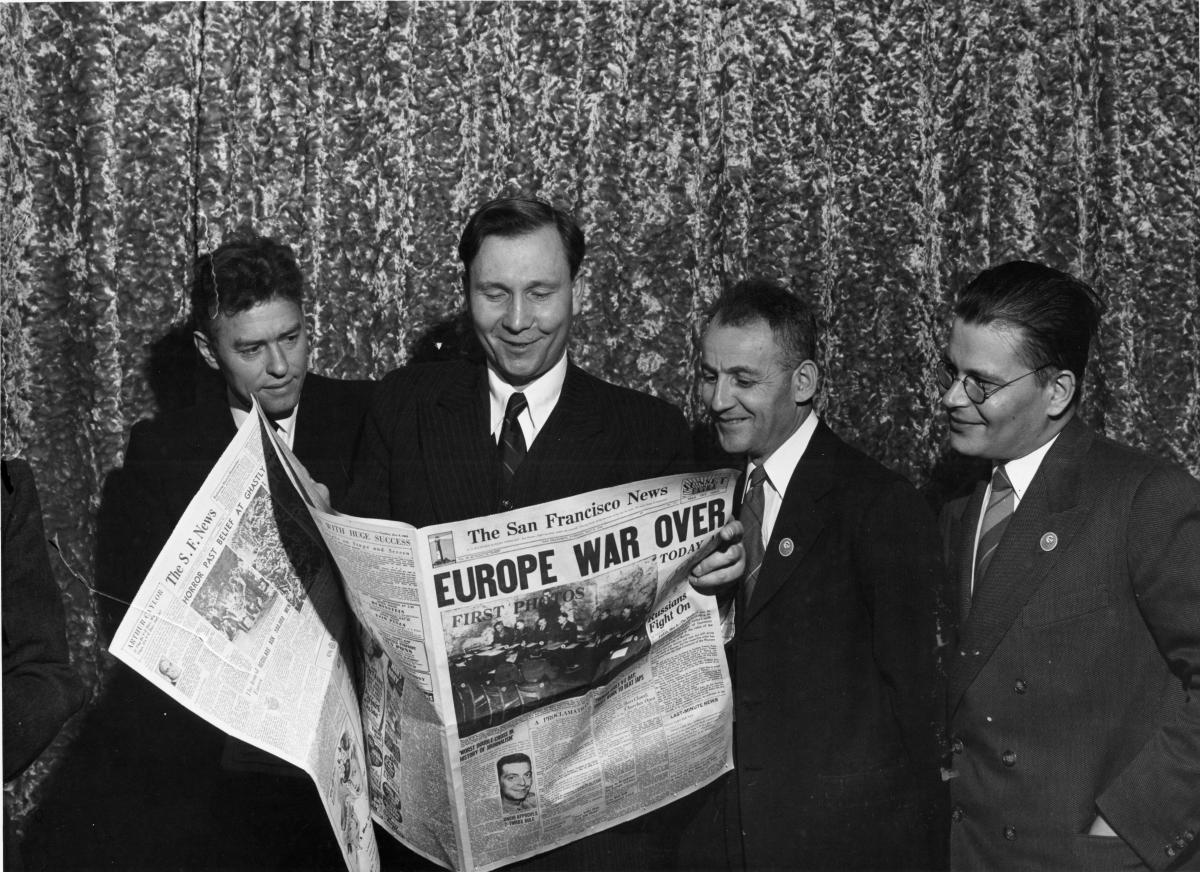 |
 |
|
Delegates vote during one of the Committee meetings at the San Francisco Conference, May 1945. |
News of the end of WWII welcomed by UNCIO Delagates. |
Liberia was one of three Nations representing the African continent along with Egypt and Ethiopia. |
|
Proposed procedure for drafting Charter |
South African Prime Minister, Jan Smuts |
Eighth Committee Summary Report |
 |
 |
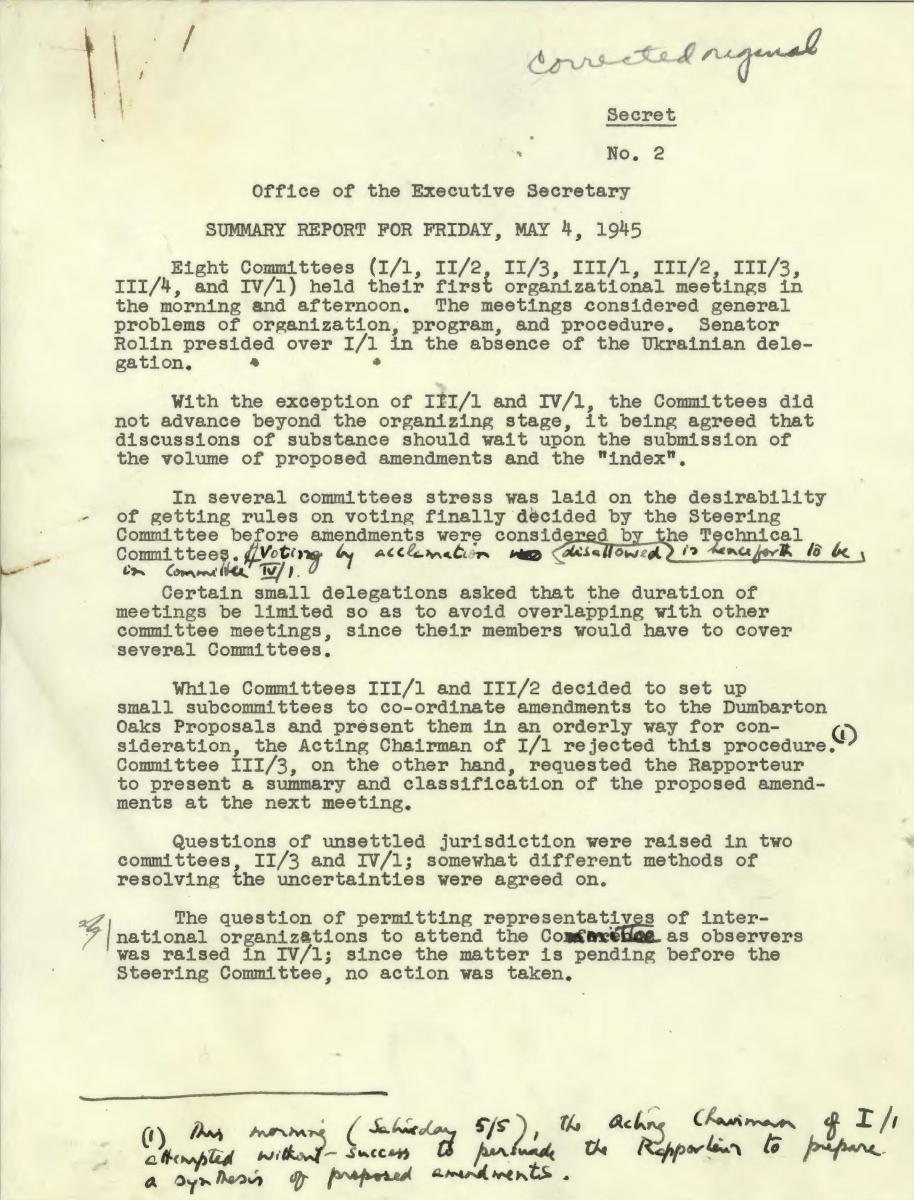 |
|
Proposed procedure for drafting the United Nations Charter. Delegates at the San Francisco Conference took the Dumbarton Oaks Proposals as a basis to draft the United Nations Charter. This document was damaged in a 2008 flood at the UN Archives. |
South African Prime Minister Jan Christian Smuts addresses the San Francisco Conference in May 1945. Smuts was instrumental to the founding of the League of Nations and was the only delegate at the Conference to sign the charters of both the United Nations and the League of Nations. He was largely responsible for drafting the Preamble of the Charter and shaping the rest of its content. However, during the post-war years, he drafted laws that later became the framework for apartheid. |
Summary Report on the work of the Commissions and Committees at the San Francisco Conference for 4 May 1945. All four Commissions and 12 Technical Committees were serviced by the International Secretariat which was responsible for planning the work of the Conference and providing administrative support functions. |
|
Document distribution at the Conference |
||
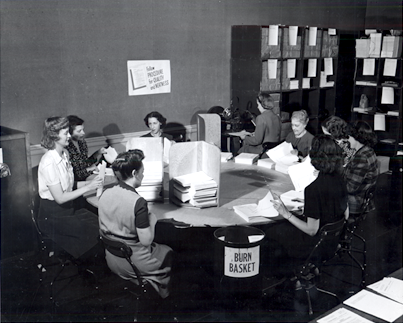 |
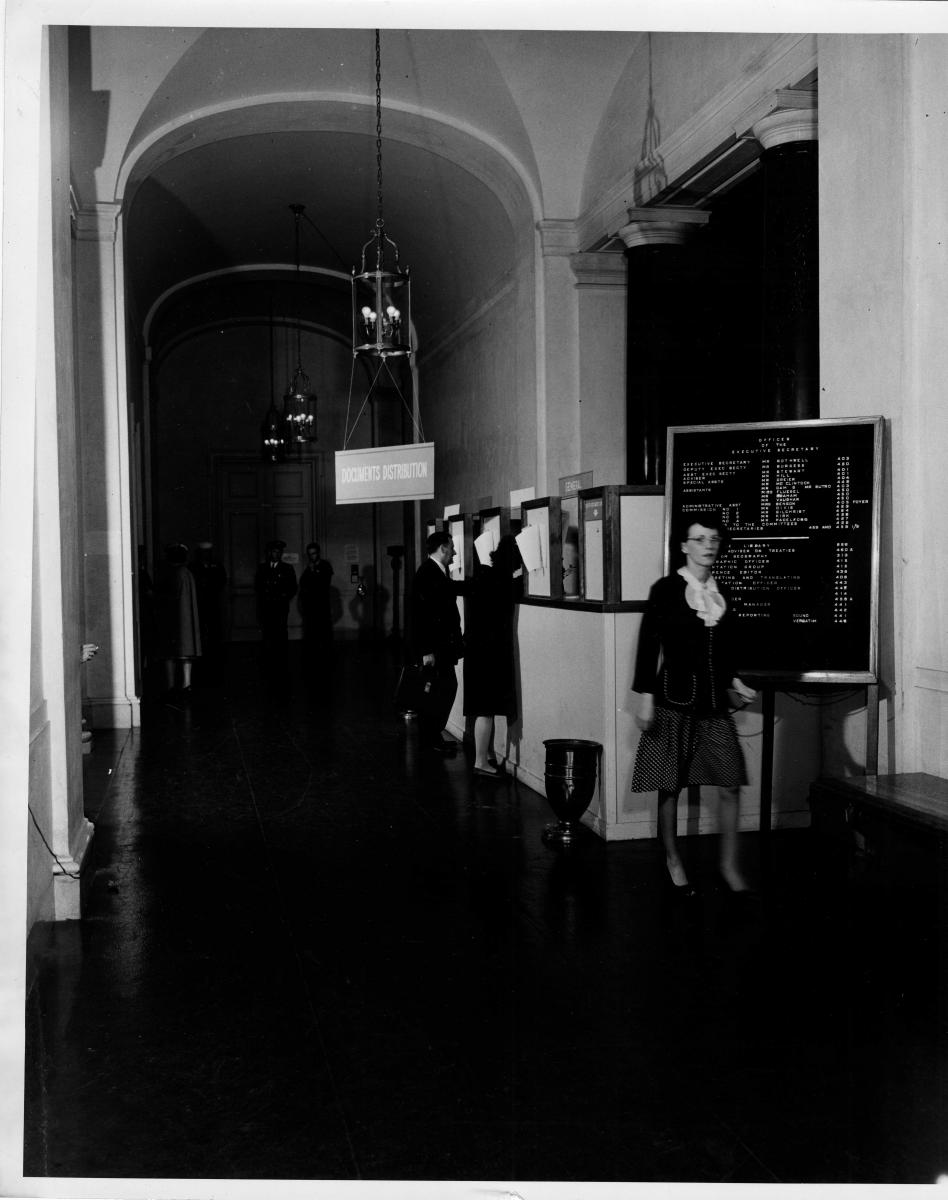 |
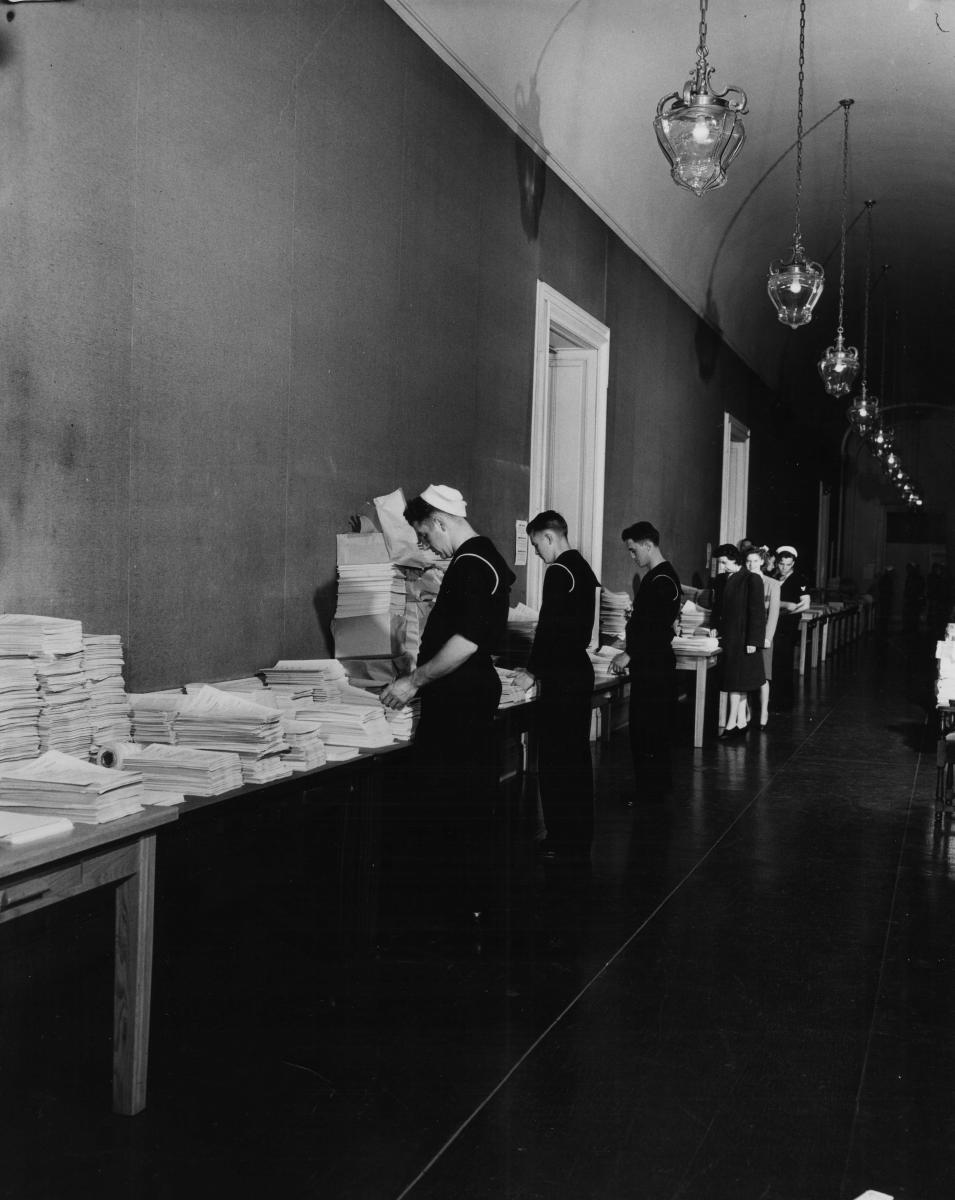 |
| International Secretariat staff organise documents for distribution to delegations. The function of the Secretariat was to plan the work of the Committees, prepare the minutes and documents, provide translation and interpretation and other support functions, April 1945. | ||
|
UNCIO Interpretation and Translation Service |
San Francisco Conference meeting procedures |
Minerva Bernardino of the Dominican Republic signs the United Nations Charter, 1945 |
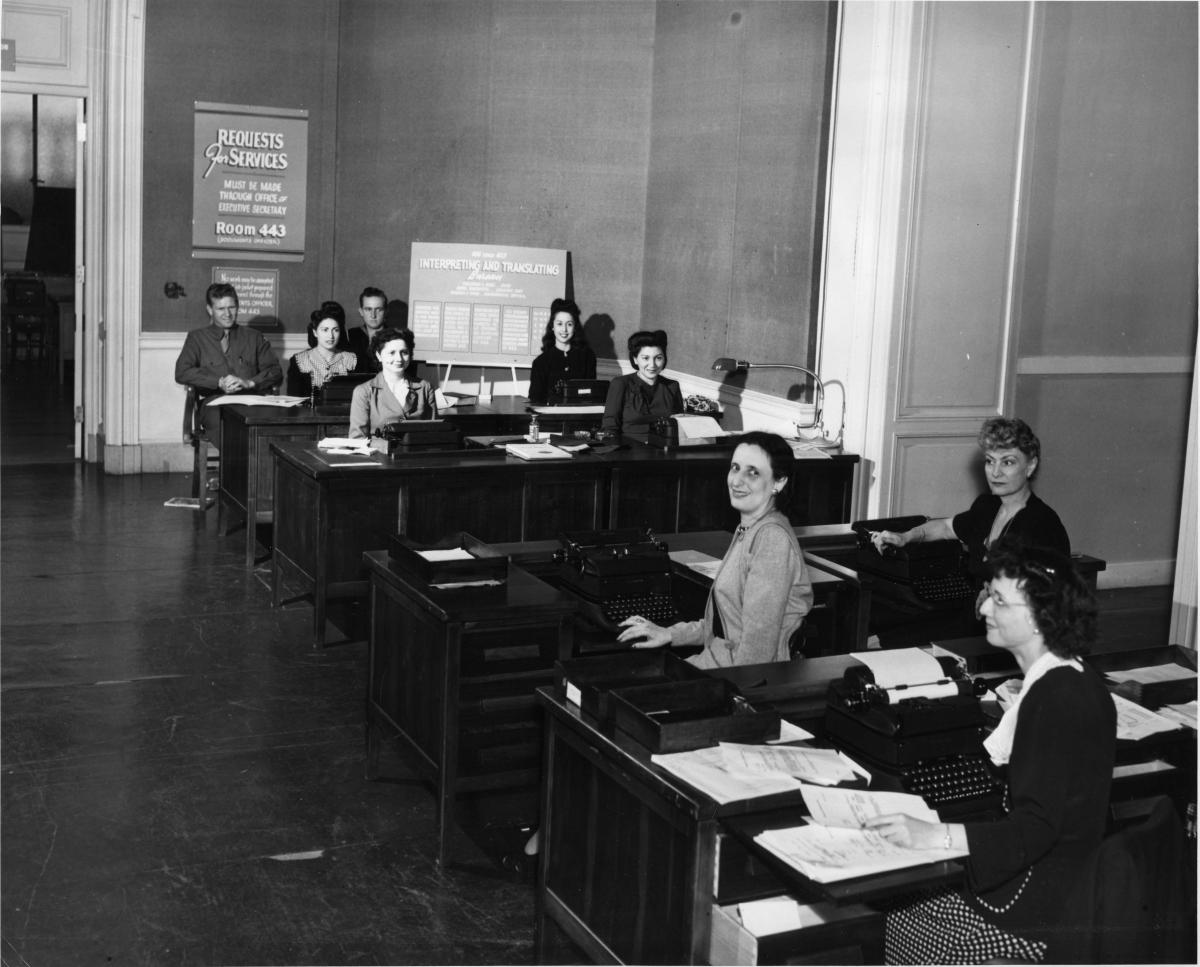 |
 |
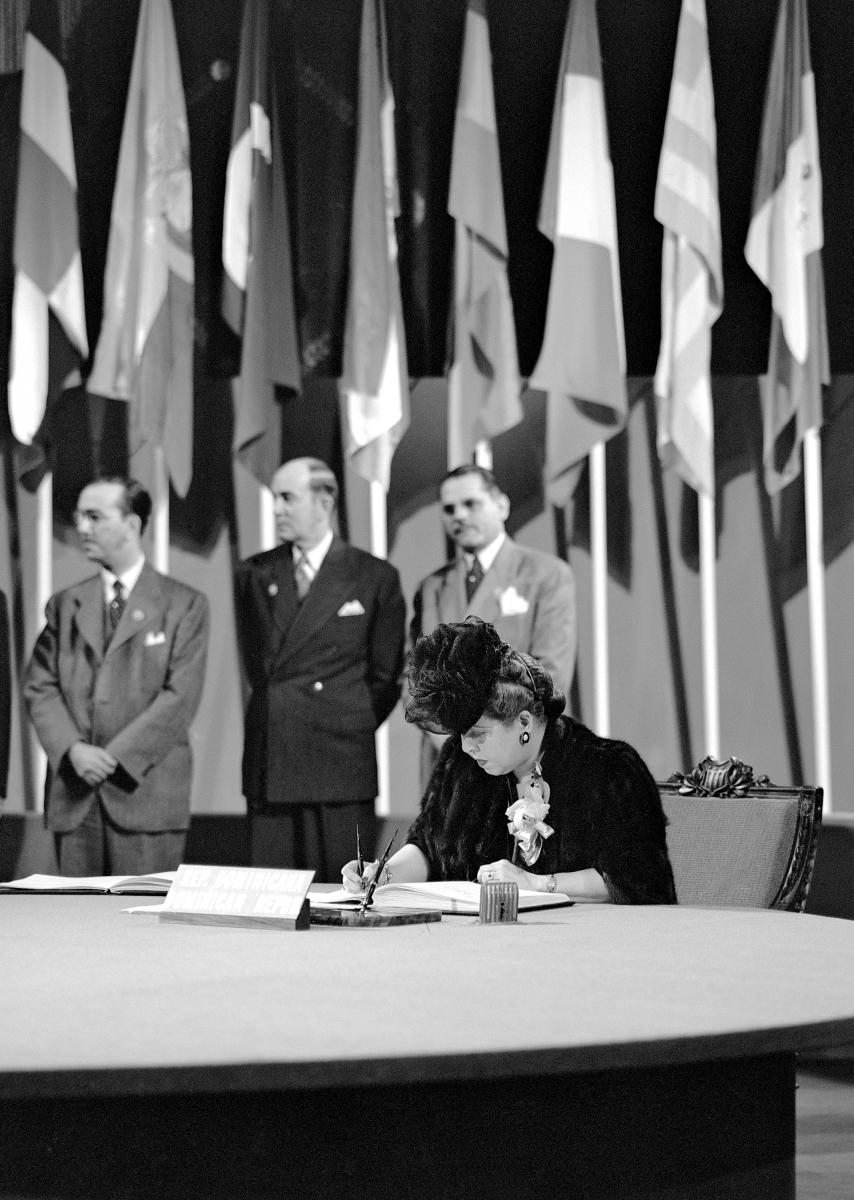 |
|
Translation was provided in the two working languages and in the five official languages of the United Nations at the time (Chinese, English, French, Russian and Spanish). |
Photograph depicting the workflow of documents being created, received and distributed to delegates during the Conference. 1945.Behind the scenes, Conference staff printed and distributed correspondence from the public, Member States and Non-Governmental Organisations, as well as internal documents on the work of the Conference. |
Ms. Bernardino was one of only four women to do so. She was a prominent women’s rights activist and she contributed to drafting the phase “respect for human rights and for fundamental freedoms for all without distinction as to race, sex, language, or religion’’ in Article I of the Charter. |
|
Certified copy of the United Nations Charter |
Radio Broadcast for UNCIO |
|
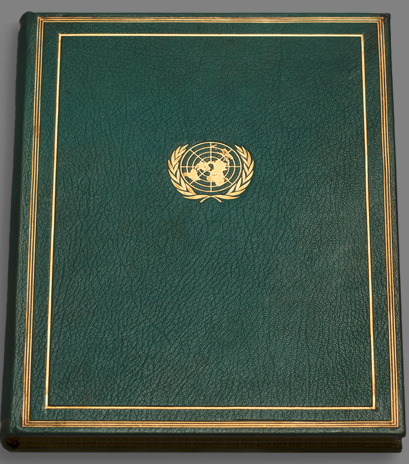 |
 |
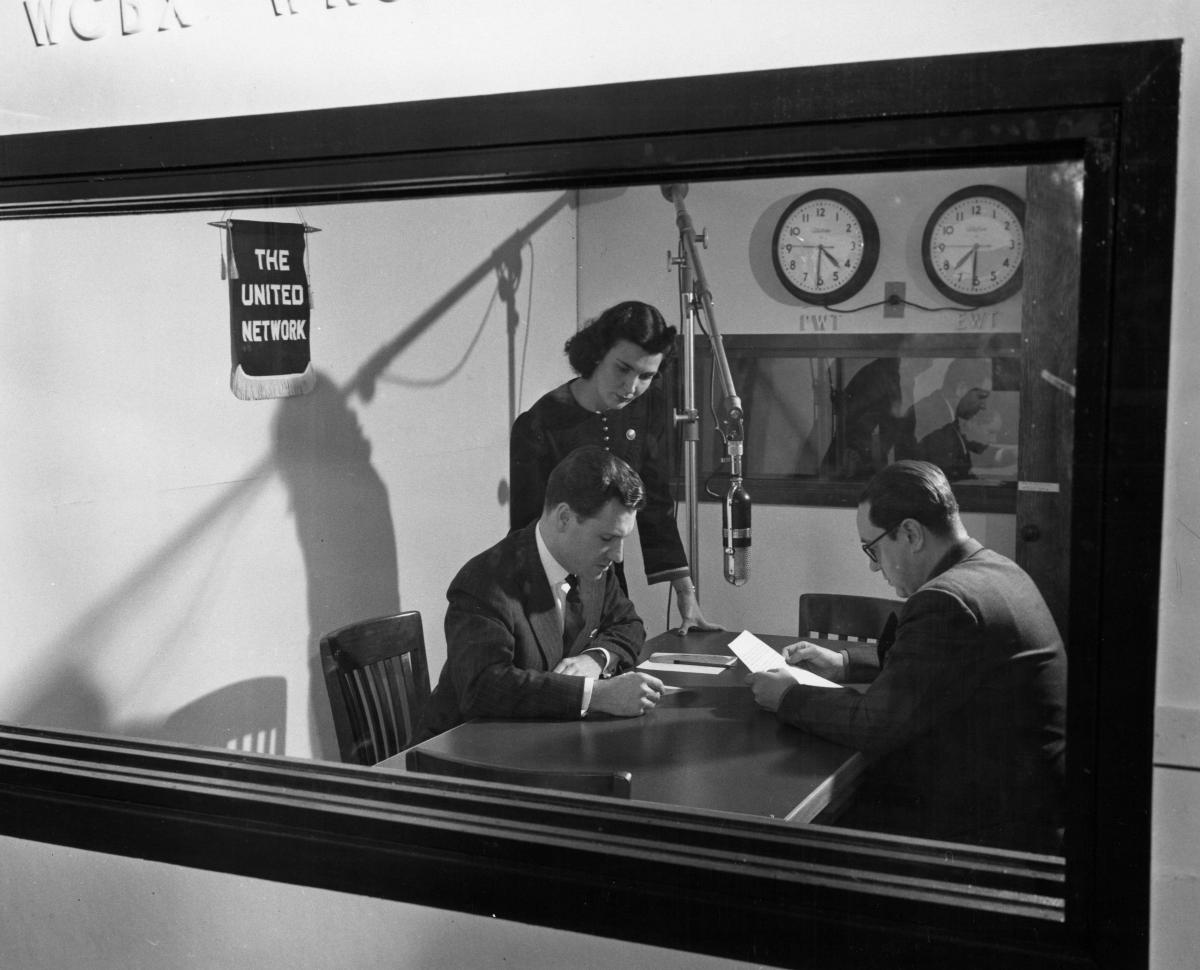 |
|
At the time the Charter was signed, it was common practice to deposit multilateral treaties with the government of the country where they were signed. The original is therefore held at the National Archives of the United States in Washington, D.C. |
KPO news staff covering the San Francisco conference, May 1945. KPO was a San Francisco-based radio. In 1947, it was absorbed by the American National Broadcasting Company (NBC) and became KNBR. |
|
The Lake Success Period
“In giving our approval to the Declaration today, it is of primary importance that we keep clearly in mind the basic character of the document. It is not a treaty; it is not an international agreement. It is not and does not purport to be a statement of law or of legal obligation. It is a Declaration of basic principles of human rights and freedoms, to be stamped with the approval of the General Assembly by formal vote of its members, and to serve as a common standard of achievement for all peoples of all nations. We stand today at the threshold of a great event both in the life of the United Nations and in the life of mankind. This Universal Declaration of Human Rights may well become the international Magna Carta of all men everywhere.”
- Eleanor Roosevelt , Chairperson of the Drafting Committee of the Declaration of Human Rights, 9 December 1948, Lake Success, New York.
The work of the United Nations in its first years (1945-51) was a sustained act of visionary institutional action, reaching into all aspects of human affairs. In its temporary quarters in Long Island, New York, the United Nations created, notably, the International Court of Justice (ICJ), the Trusteeship Council, the International Atomic Energy Commission (IAEC),the World Health Organisation (WHO), the United Nations Educational, Scientific and Cultural Organisation (UNESCO), the United Nations International Children’s Emergency Fund (UNICEF), modernized the League of Nations-era International Labour Organisation (ILO), and transformed the temporary wartime United Nations Relief and Rehabilitation Administration (UNRRA) into the International Refugee Organization (IRO).
This was a time during which the borders and identities of countries around the world were in flux. United Nations membership expanded, some Member States declared their independence hereby creating new national identities. Now that WWII was over, negotiating and maintaining the peace was the practical responsibility of the new UN Security Council, made up of the United States, Great Britain, France, the Soviet Union, and China.
|
Lake Success
|
Independent India's flag being raised at Lake Success
|
Eleanor Roosevelt
|
|---|---|---|
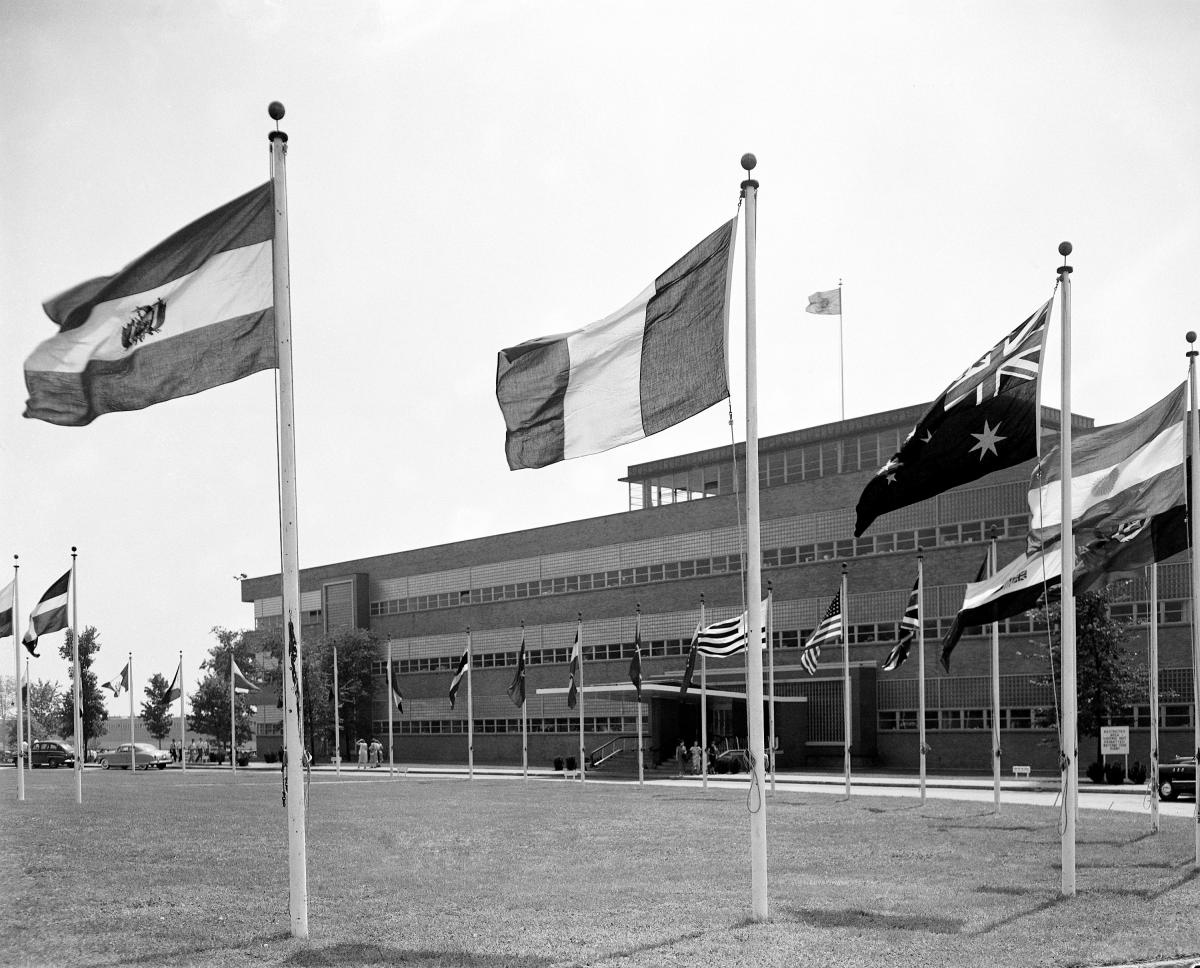 |
 |
 |
| Lake Success in northwest Long Island, New York was the temporary home of the United Nations. Secretariat staff worked there between 1946 and 1951, while the General Assembly and other United Nations bodies met in Flushing, Queens (now the site of the Queens Museum).
Flags of the original 51 Member States hoisted at the Lake Success Headquarters. The original flags are still held today by the United Nations Archives. |
Raising independent India’s flag for the first time at Lake Success, 15 August 1947. | Eleanor Roosevelt, who was appointed as the United States Delegate to the United Nations, listens to debates during a session of the General Assembly. She was Chairperson of the Committee to draft the Universal Declaration of Human Rights, which was adopted unanimously by the General Assembly on 10 December 1948. |
Members of the Jewish Agency for Israel's delegation
|
Suggested seating arrangements
|
Protocol for raising the flags
|
 |
 |
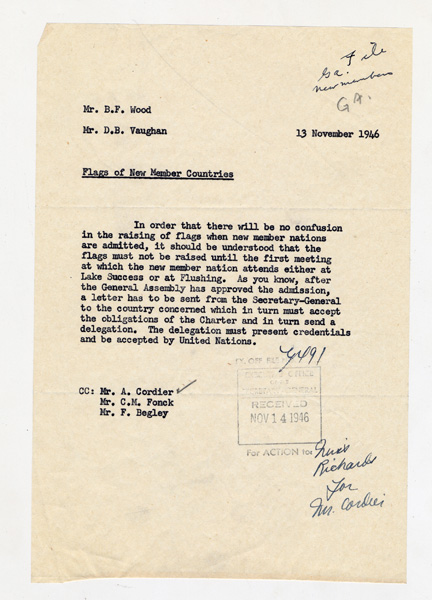 |
| Members of the Jewish Agency for Israel’s delegation study a map of the proposed partition of Palestine at Lake Success, 12 November 1947. Picture: left to right are: Dr. Nahum Goldman, David Horovitz, Emanuel Neumann and Rabbi Wolf Gold. | Interoffice memorandum on suggested seating arrangements for the first meeting of the General Assembly, 22 August 1946.
The first meeting of the General Assembly took place on 16 September 1946 in Flushing Meadows, Queens, New York (now the site of the Queens Museum). |
Interoffice memorandum concerning the protocol for raising the flags of new Member States, 13 November 1946.The flag code was amended in November 1952 with ST/SGB/132 and remains in effect today. |
Various suggestions on where the United Nations Headquarters should be established
|
Telex sent on behalf the UN Secretary-General Trygve Lie to William O'Dwyer, Mayor of New York City
|
|
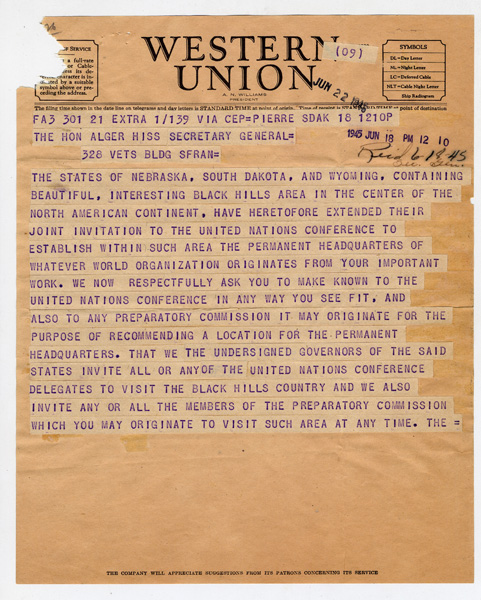 |
 |
 |
| The question of where the United Nations should establish its headquarters was raised even before the San Francisco Conference. During the Conference, the Secretariat received numerous official invitations and private suggestions, like this one from the Governors of Nebraska, South Dakota and Wyoming in the United States on 18 June 1945.
Among the proposed locations were Washington D.C (United States), Vienna (Austria), Montreal (Canada) and the Rockefeller Estate in Westchester County, New York (United States). |
Telex sent on behalf of Trygve Lie, UN Secretary-General (1946-1952), to William O’Dwyer, Mayor of New York (1946-1950) on 10 April 1946. The question of where the United Nations headquarters should be located was decided when John D. Rockefeller donated an 18-acre plot of land in Manhattan to the City of New York for the purpose of housing the United Nations. | |
Humanitarian Action
“Recently--a few days ago I heard Mr. McDougall representing the Food and Agriculture Organisation of the United Nations tell you about the needs of these countries, the shortage of food. He was telling you about calories. Now, Gentlemen, please don’t go off on calories. What these countries need is not a dietician. They need a Quartermaster. They need the food...”
Address by Fiorello H. LaGuardia, Director-General of UNRRA to the Second Committee (Economic and Financial) of the First Session of the United Nations General Assembly on 11 November 1946.
Following the defeat of Germany and Japan, tens of millions of refugees, displaced persons and prisoners of war struggled to survive in the face of extreme devastation and shortages of food, fuel clothing and essential goods. Many had nowhere to go, and could not return to their homes, now occupied by survivors and former enemies as desperately in need as they. Throughout the post-war period, the United Nations worked with Member States to find solutions for the resettlement of Jewish Holocaust survivors, stateless persons and refugees.
Between 1943 and 1947, the United Nations Relief and Rehabilitation Administration (UNRRA) distributed approximately US$4 billion worth of goods, food, medicine, tools, and farm implements to devastated areas. In April 1946, the newly founded United Nations took over the work of UNRRA and created the International Refugee Organisation (IRO) in 1947. IRO was charged with dealing with the refugee problem created by WWII in areas controlled by Western Armies of occupation. IRO ceased operations in 1952 and was replaced by the United Nations High Commissioner for Refugees (UNHCR).
|
Memorandum to Sir Raphael Cilento, Director for Social Activities
|
Draft ECOSOC Document
|
|
|---|---|---|
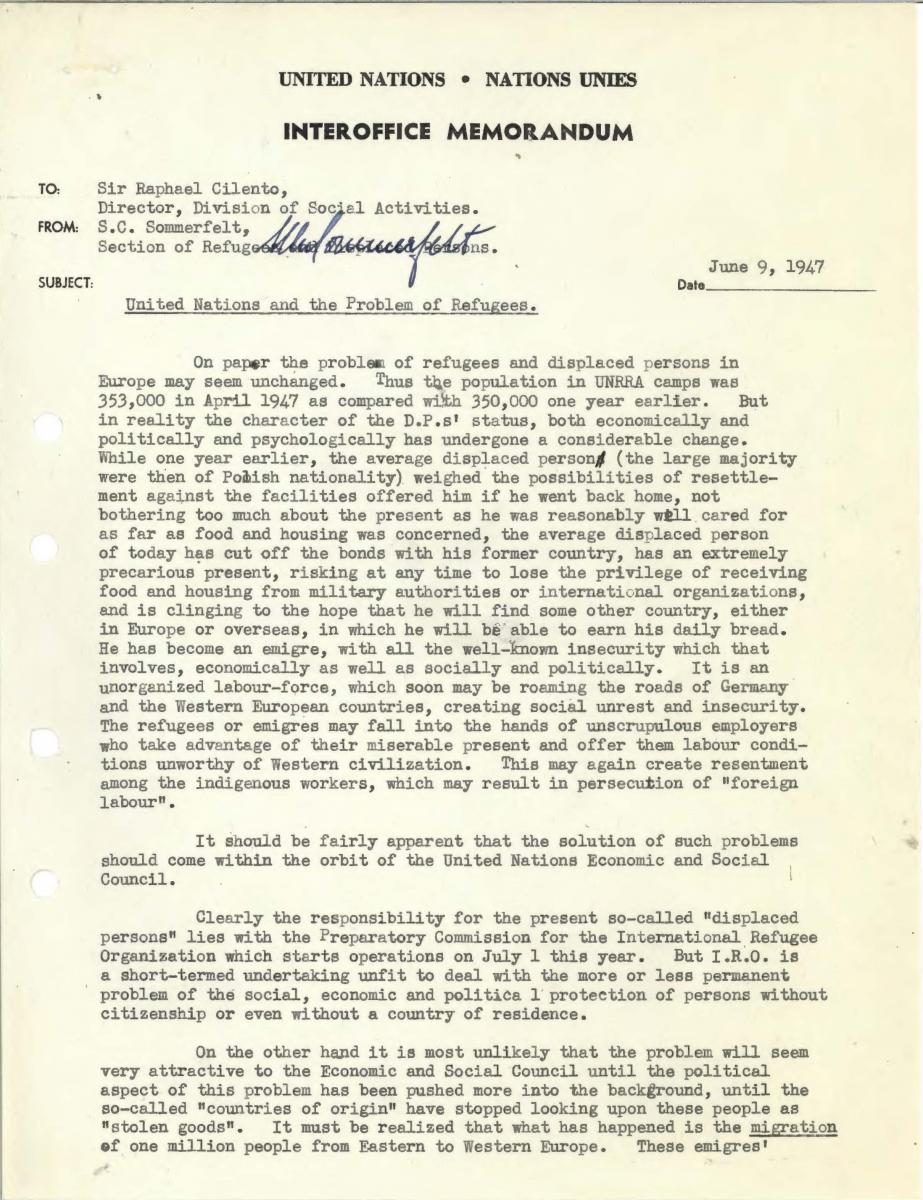 |
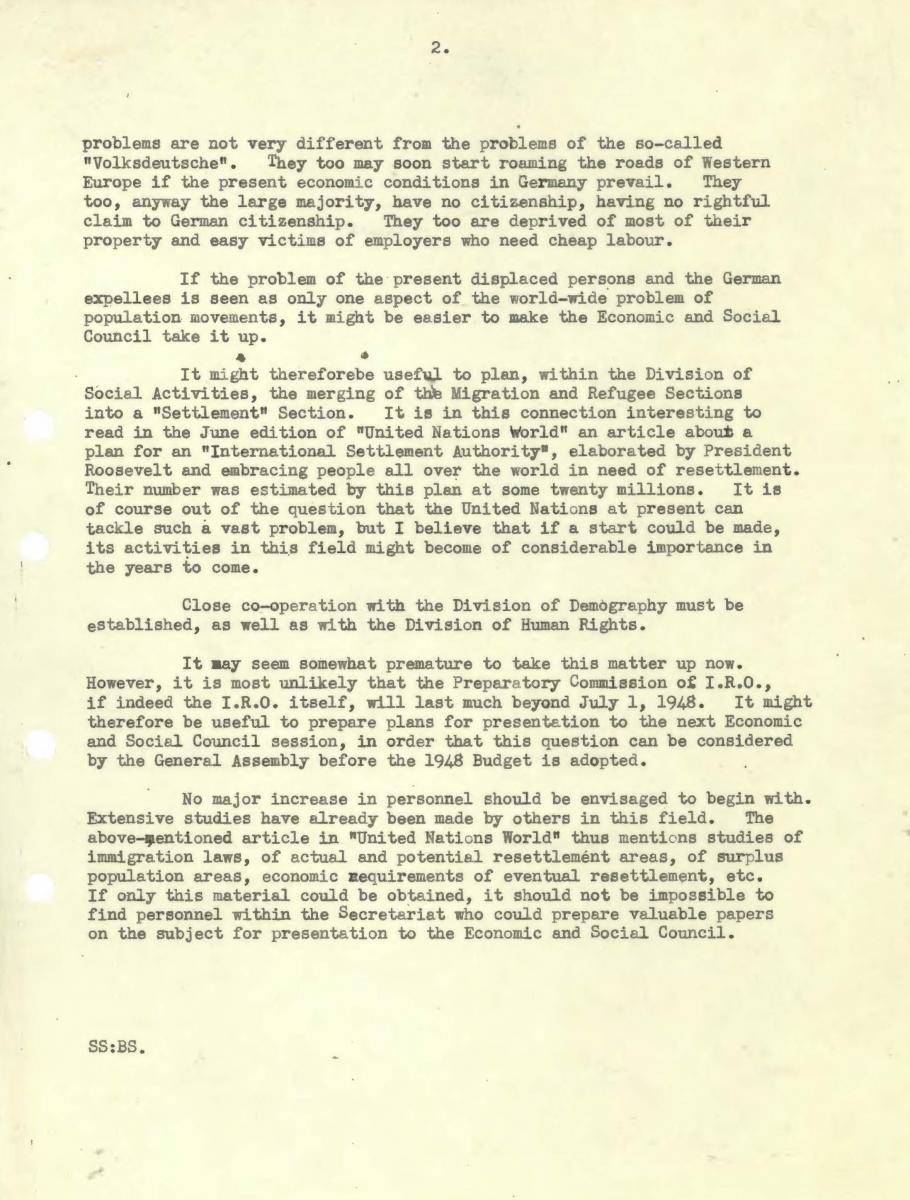 |
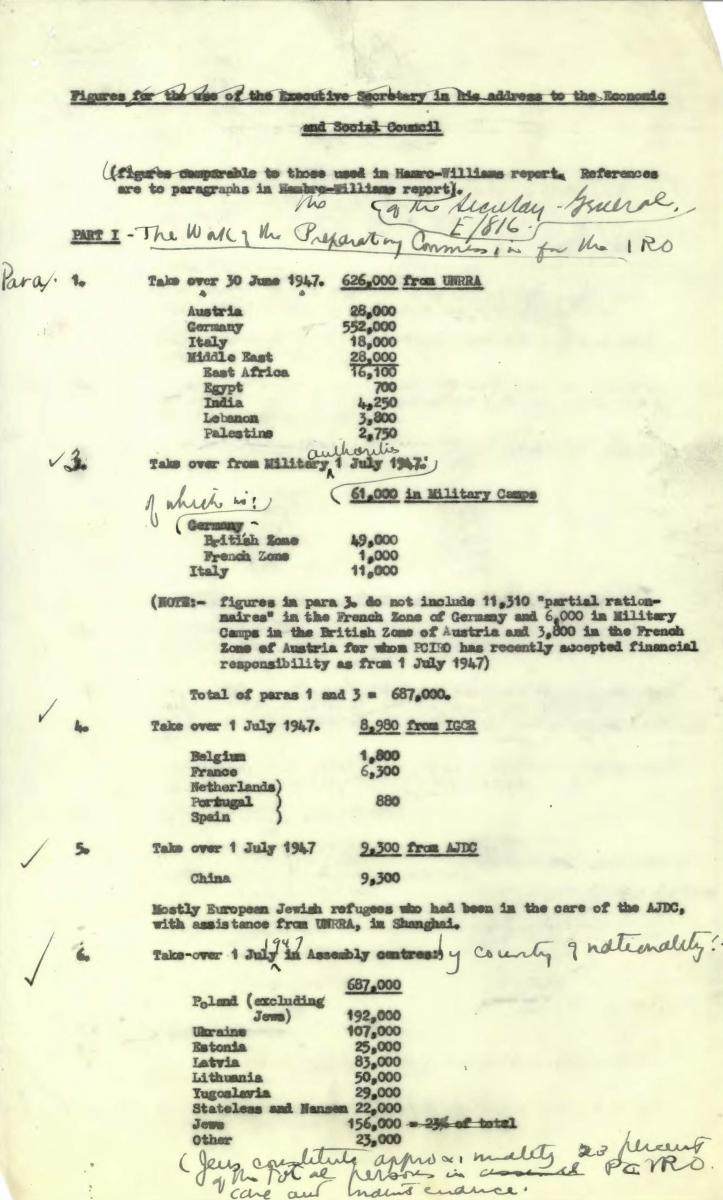 |
|
Memorandum from the Section of Refugees and Displaced Persons to Sir Raphael Cilento, Director for Social Activities, June 1947. The memo suggests a reorganisation of the structure of the UN refugees and stateless persons programme and to bring the matter to the UN Economic and Social Council. |
Annotated document for the Executive Secretary of the Preparatory Commission for the International Refugees Organization’s address to the UN Economic and Social Council in 1948. |
|
|
Briefing at the UNRRA Mobilization and Training Centre
|
Statistics on refugees
|
Chinese refugees, 1946
|
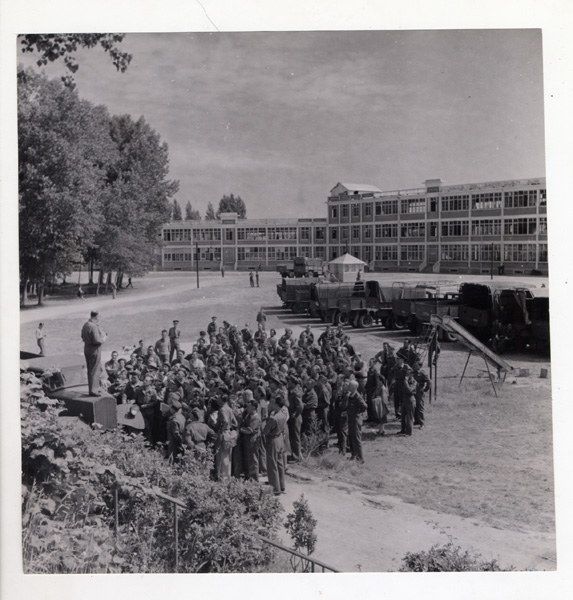 |
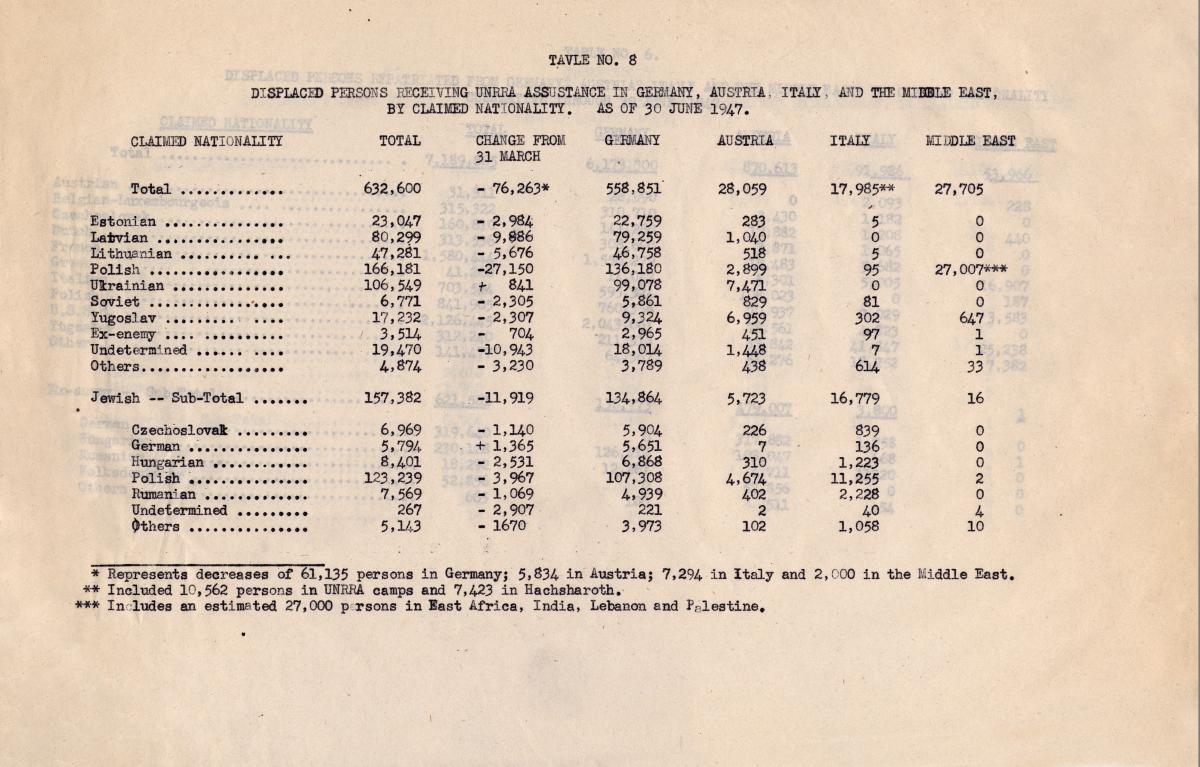 |
 |
|
UNRRA personnel being briefed at the UNRRA Mobilization and Training Centre at Granville in France, 1946. Between 1943 and 1946, UNRRA recruited more than 10,000 highly specialised staff from at least 43 nations. These employees took an oath to adhere to the ideal of international service and agreed to abstain from any act of discrimination on account of race, nationality, creed, or political belief. |
A table showing the distribution of refugees and Stateless Persons in Europe as of 30 June 1947. |
Chinese refugees, 1946. At the end of WWII, some 15,000 Chinese Displaced Persons were dispersed throughout Europe and Asia, with the largest concentrations in Calcutta and Singapore. |
|
Letter reporting on the status of Chinese displaced persons
|
Reconstruction by UNRRA personnel
|
Newspaper clipping describing financial woes of the IRO
|
 |
 |
 |
|
A letter from the Chinese representative to the UN Economic and Social Council to the Division of Refugees reporting on the status Chinese displaced persons, 22 October 1946. |
UNRRA personnel help rebuild a town in Italy, August 1946. Among difficulties faced by inhabitants is water shortage, as only a trickle of water arrives at the fountain. The lines of cans mark the owner’s places as they wait for their turn. UNRRA helped restore the town aqueduct which was destroyed during the fighting. |
New York Times article, 23 June 1947, describes the financial woes of the International Refugees Organization (IRO) at its inception as it prepares to take over the role of UNRRA in June 1947. Although funding has been pledged by Member States to support the IRO’s work, millions of dollars are needed immediately to continue providing food and shelter for refugees in Europe. |
|
Letters between a refugee and UNRRA
|
||
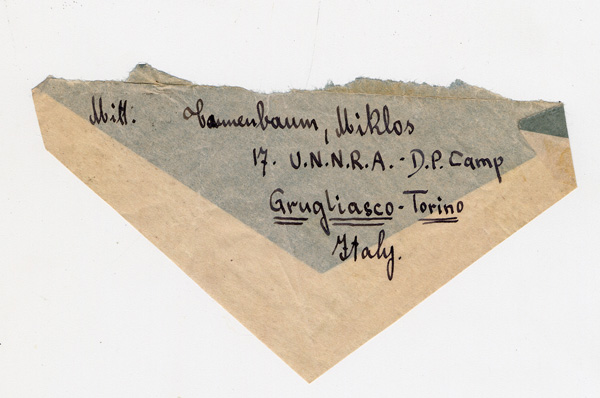 |
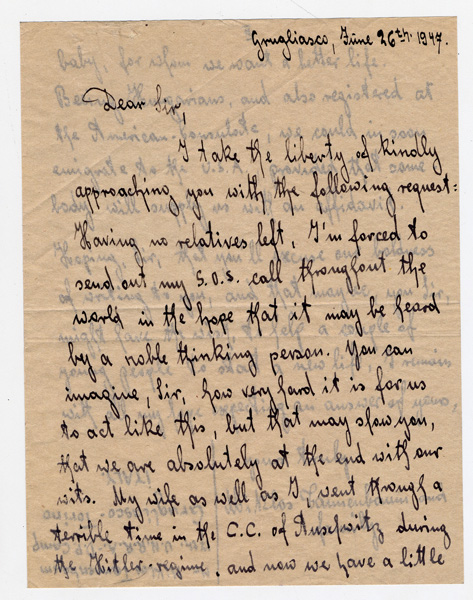 |
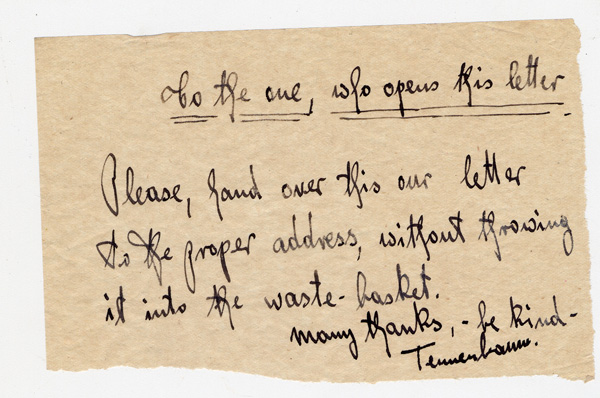 |
 |
 |
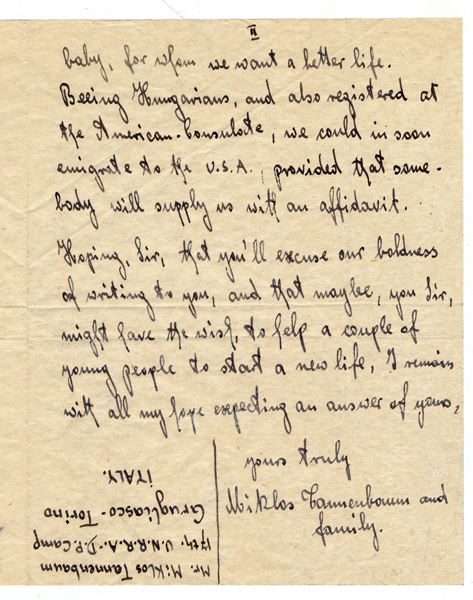 |
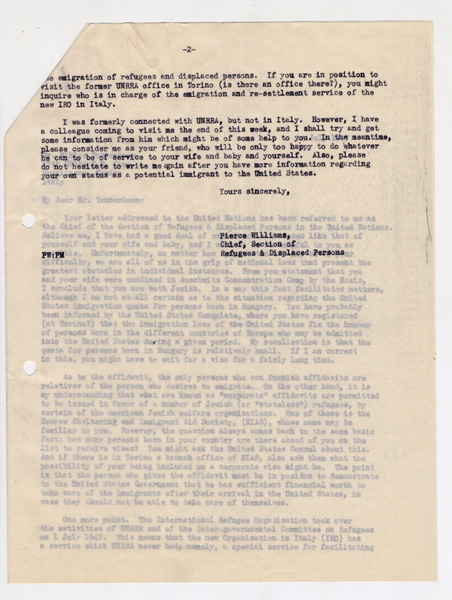 |
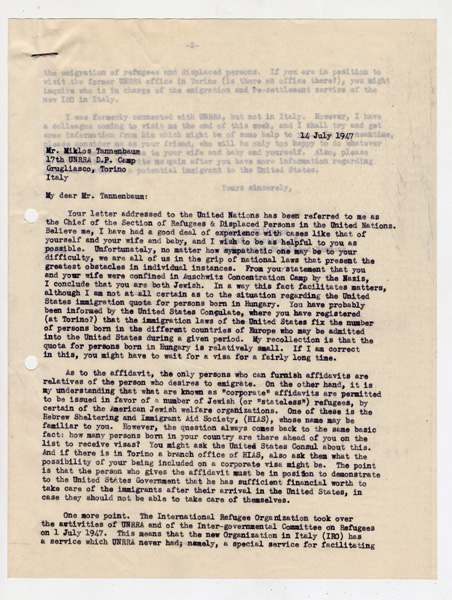 |
Letters exchanged between Miklos Tennenbaum, a Jewish refugee in an Italian camp wishing to immigrate to the United States, and Pierce Williams, United Nations Director of Refugees and Displaced Persons. June 1947. |
|
Cable confirming that emergency funding will be provided to the IRO
|
Harry Saunders' suitcase
|
|
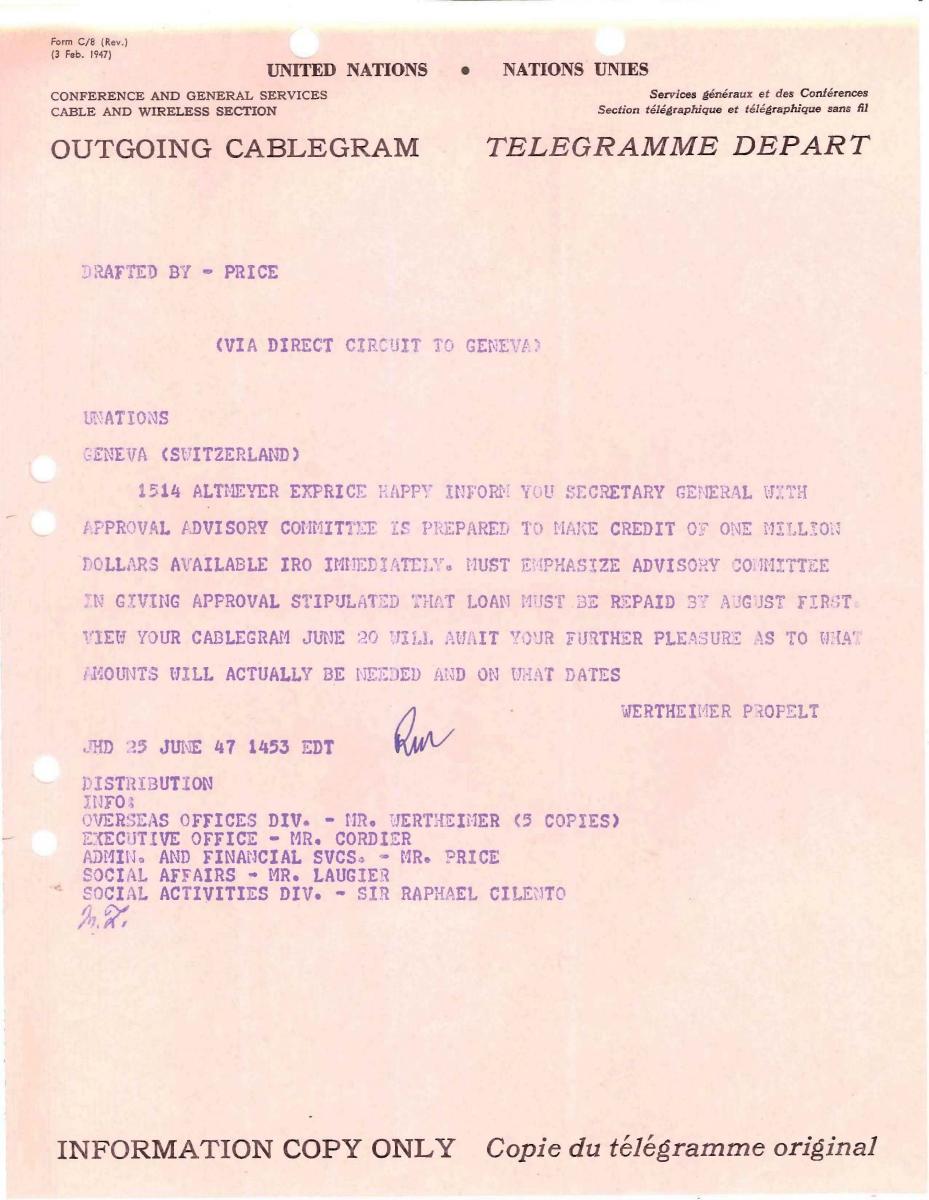 |
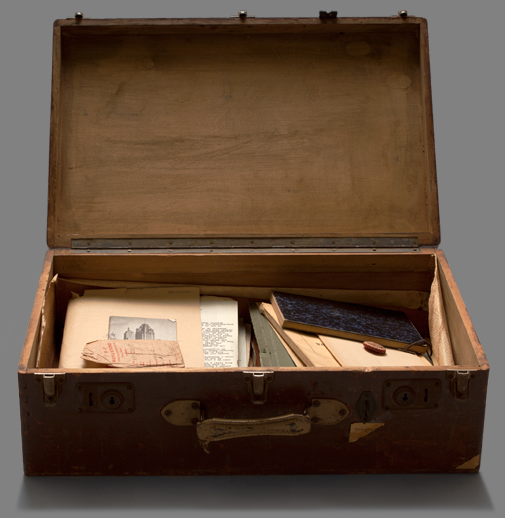 |
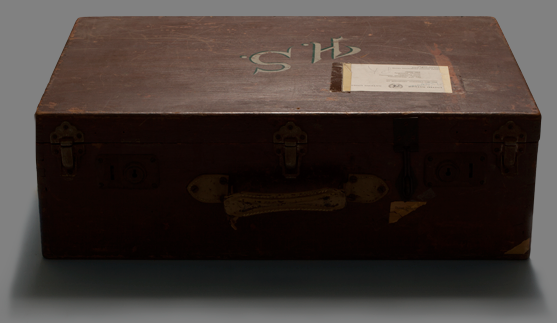 |
|
United Nations cable 25 June 1947 which confirms that emergency funding will be provided to the International Refugees Organization (IRO) through a temporary loan to continue the work of UNRRA. At this point, IRO status had not been ratified by the required fifteen Member States and therefore had not received the necessary financial contributions. |
Harry Saunders was a British Director of Training for the United Nations Relief and Rehabilitation Administration (UNRRA). The Archives and Records Management Section received it in the 1960s. It contains scrapbooks, photographs and interviews with displaced persons, diaries and training materials for UNRRA staff working with refugees in Europe. |
|
Disarmament and Non-Proliferation
“In the past, science has often been able to provide adequate protection against new weapons it has given into the hands of an aggressor, but it cannot promise such efficient protection against the destructive use of nuclear power. This protection can only come from the political organisation of the world. Among all arguments calling for an efficient international organisation for peace, the existence of nuclear weapons is the most compelling one.”
- The Franck Report, 11 June 1945.
Following the discovery of the neutron in 1932, scientists quickly realised its potential to create a bomb of unprecedented force. After Hitler invaded Austria and Czechoslovakia in 1938, an international group of scientists, including Albert Einstein, Leo Szilard, and Edward Teller, contacted President Roosevelt to warn him of the threat. By 1940, the United States, in cooperation with Great Britain and Canada, had a secret weapons programme, and successfully detonated the first atomic bomb in August 1945.
The Soviet Union had known of the program since 1943, and by the end of WWII, it had its own atomic bomb programme. The dangers of a post-war nuclear arms race were evident to scientists and others, who submitted the Franck Report to President Truman, urging him, to demonstrate the new weapon to representatives of the United Nations on a deserted or barren island. The UN General Assembly resolution I of January 1946 called for the creation of the United Nations Atomic Energy Commission to “deal with the problems raised by the discovery of atomic energy”. The First Committee of the General Assembly on atomic energy and the role of the Atomic Energy Commission was held in Paris at the Palais Chaillot. October 1948. The Atomic Energy Commission was to make specific proposals to promote basic scientific information sharing on the peaceful use of nuclear energy; on the elimination of atomic weapons from national armaments and on the development of an effective safeguard and inspection system. One of the functions of the Atomic Energy Commission was to query leading scientists and intellectuals with the aim of creating a comprehensive bibliography of information and promote scientific knowledge sharing about atomic energy. British philosopher Bertrand Russell later became the first President of the UK-based Campaign for Nuclear Disarmament. Because of the disagreements between the Western Powers and the Soviet Union concerning the international control of fissile material production before achieving disarmament, the UN Atomic Energy Commission ceased its work in 1949 and was officially closed in 1952. Alarmed at the prospect of nuclear technology proliferating around the world and the number of Member States with atomic bomb making capabilities, United States President Dwight D. Eisenhower proposed the “Atom for Peace” programme in 1953, leading to the establishment of the International Atomic Energy Agency (IAEA) in 1957.
|
Destruction of Hiroshima, 6 August 1945
|
US Military photograph of the nuclear cloud above Nagasaki, 9 August 1945
|
|
|---|---|---|
 |
 |
|
|
Hiroshima was the first Japanese city to be bombed on 6 August 1945. On detonation, the temperature reached 60 million degrees. More than 100,000 men, women and children were killed by the blast, the heat and radiation. The bomb obliterated 60,000 buildings. |
US military photograph of the nuclear cloud rising above Nagasaki, Japan, 9 August 1945. Following the Nagasaki bombing and the invasion of Japan by the Soviet Union on 8 August, Emperor Hirohito intervened and ordered the Supreme Council to accept the terms the Allies had set in the Potsdam Declaration for ending the war. Japan surrendered officially on 15 August 1945. (Library of Congress photo). |
|
|
Opening address to the first meeting of the UN Atomic Energy Commission by Bernard M. Baruch
|
Letter from the Delegation of the Soviet Union to the Chair of the UN General Assembly’s First Committee, November 1946
|
|
 |
 |
 |
|
Bernard M. Baruch, United States representative and temporary Chairperson, delivers his opening address to the first meeting of the UN Atomic Energy Commission. The Baruch Plan of 14 June 1946 included the United State’s agreement to destroy its nuclear weapons on the condition that all other countries pledge not to produce them, and agree to international inspection. At the end of 1946, the Atomic Energy Commission reported to the Security Council that “it was useless to continue its work until a political accord had been reached between the Western Powers and the Soviet Union”. In 1947, the negotiations reached an impasse; thereby implying that an agreement was going to be unlikely. |
Letter from the Delegation of the Soviet Union to the Chair of the UN General Assembly’s First Committee, November 1946. In this additional proposal submitted to the First Committee, the Soviet Delegation, led by Andrei Gromyko requested for the following proposal to be put to a vote. “The General Assembly deems it necessary that all States Members [sic] of the United Nations organization should submit information regarding armed forces and armaments in their own territory, this information to be submitted when the Security Council will consider the proposals for the general reduction of armaments. |
|
|
Australian draft resolution on non-proliferation for discussion at the First Committee
|
||
 |
 |
|
| Draft Resolution submitted by the Delegation of Australia in December 1947 at the Twelfth meeting of the Working Committee of the Commission for Conventional Armaments. | ||


